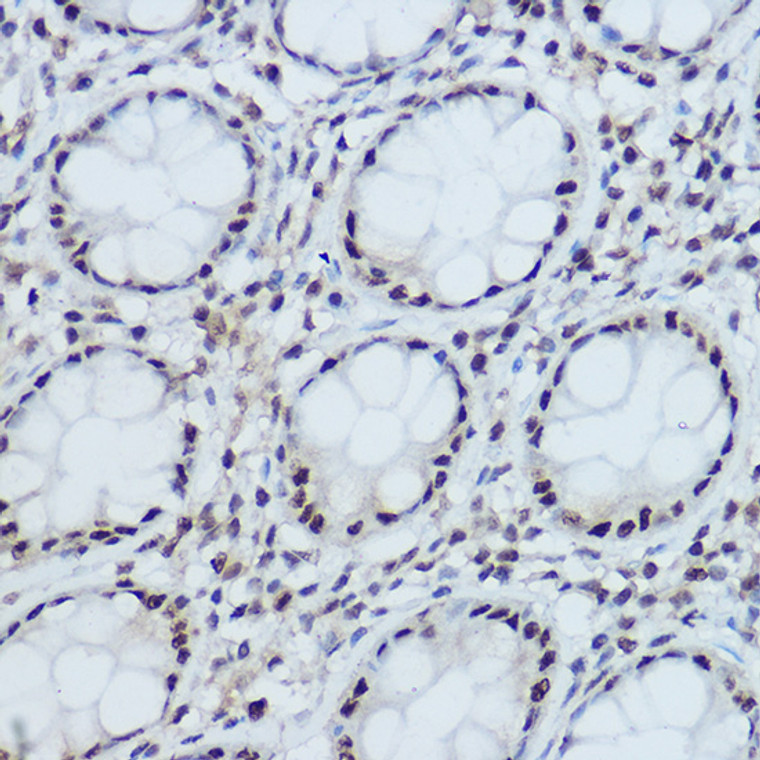| Host: |
Rabbit |
| Applications: |
WB/IHC/IP |
| Reactivity: |
Human/Mouse/Rat |
| Note: |
STRICTLY FOR FURTHER SCIENTIFIC RESEARCH USE ONLY (RUO). MUST NOT TO BE USED IN DIAGNOSTIC OR THERAPEUTIC APPLICATIONS. |
| Short Description: |
Rabbit polyclonal antibody anti-DDB1 (C-Term) is suitable for use in Western Blot, Immunohistochemistry and Immunoprecipitation research applications. |
| Clonality: |
Polyclonal |
| Conjugation: |
Unconjugated |
| Isotype: |
IgG |
| Formulation: |
PBS with 0.02% Sodium Azide, 50% Glycerol, pH7.3. |
| Purification: |
Affinity purification |
| Dilution Range: |
WB 1:500-1:2000IHC-P 1:100-1:500IP 1:500-1:1000 |
| Storage Instruction: |
Store at-20°C for up to 1 year from the date of receipt, and avoid repeat freeze-thaw cycles. |
| Gene Symbol: |
DDB1 |
| Gene ID: |
1642 |
| Uniprot ID: |
DDB1_HUMAN |
| Immunogen Region: |
C-Term |
| Immunogen: |
A synthetic peptide corresponding to a sequence within amino acids 1000 to the C-terminus of human DDB1 (NP_001914.3). |
| Immunogen Sequence: |
LGEFVNVFCHGSLVMQNLGE TSTPTQGSVLFGTVNGMIGL VTSLSESWYNLLLDMQNRLN KVIKSVGKIEHSFWRSFHTE RKTEPATGFIDGDLIESFLD ISRPKMQEVVANLQYDDGSG MKREATADDLIKVVEELTRI H |
| Post Translational Modifications | Phosphorylated by ABL1. Ubiquitinated by CUL4A. Subsequently degraded by ubiquitin-dependent proteolysis. Acetylated, promoting interaction with CUL4 (CUL4A or CUL4B) and subsequent formation of DCX (DDB1-CUL4-X-box) E3 ubiquitin-protein ligase complexes. Deacetylation by SIRT7 impairs the interaction with CUL4 (CUL4A or CUL4B) and formation of DCX (DDB1-CUL4-X-box) E3 ubiquitin-protein ligase complexes. |
| Function | Protein, which is both involved in DNA repair and protein ubiquitination, as part of the UV-DDB complex and DCX (DDB1-CUL4-X-box) complexes, respectively. Core component of the UV-DDB complex (UV-damaged DNA-binding protein complex), a complex that recognizes UV-induced DNA damage and recruit proteins of the nucleotide excision repair pathway (the NER pathway) to initiate DNA repair. The UV-DDB complex preferentially binds to cyclobutane pyrimidine dimers (CPD), 6-4 photoproducts (6-4 PP), apurinic sites and short mismatches. Also functions as a component of numerous distinct DCX (DDB1-CUL4-X-box) E3 ubiquitin-protein ligase complexes which mediate the ubiquitination and subsequent proteasomal degradation of target proteins. The functional specificity of the DCX E3 ubiquitin-protein ligase complex is determined by the variable substrate recognition component recruited by DDB1. DCX(DDB2) (also known as DDB1-CUL4-ROC1, CUL4-DDB-ROC1 and CUL4-DDB-RBX1) may ubiquitinate histone H2A, histone H3 and histone H4 at sites of UV-induced DNA damage. The ubiquitination of histones may facilitate their removal from the nucleosome and promote subsequent DNA repair. DCX(DDB2) also ubiquitinates XPC, which may enhance DNA-binding by XPC and promote NER. DCX(DTL) plays a role in PCNA-dependent polyubiquitination of CDT1 and MDM2-dependent ubiquitination of TP53 in response to radiation-induced DNA damage and during DNA replication. DCX(ERCC8) (the CSA complex) plays a role in transcription-coupled repair (TCR). The DDB1-CUL4A-DTL E3 ligase complex regulates the circadian clock function by mediating the ubiquitination and degradation of CRY1. DDB1-mediated CRY1 degradation promotes FOXO1 protein stability and FOXO1-mediated gluconeogenesis in the liver. By acting on TET dioxygenses, essential for oocyte maintenance at the primordial follicle stage, hence essential for female fertility. Maternal factor required for proper zygotic genome activation and genome reprogramming. |
| Protein Name | Dna Damage-Binding Protein 1Ddb P127 SubunitDna Damage-Binding Protein ADdbaDamage-Specific Dna-Binding Protein 1Hbv X-Associated Protein 1Xap-1Uv-Damaged Dna-Binding FactorUv-Damaged Dna-Binding Protein 1Uv-Ddb 1Xpe-Binding FactorXpe-BfXeroderma Pigmentosum Group E-Complementing ProteinXpce |
| Database Links | Reactome: R-HSA-110314Reactome: R-HSA-5696394Reactome: R-HSA-5696395Reactome: R-HSA-5696400Reactome: R-HSA-6781823Reactome: R-HSA-6781827Reactome: R-HSA-6782135Reactome: R-HSA-6782210Reactome: R-HSA-8951664 |
| Cellular Localisation | CytoplasmNucleusPrimarily CytoplasmicTranslocates To The Nucleus Following Uv Irradiation And Subsequently Accumulates At Sites Of Dna DamageMore Concentrated In Nuclei Than In Cytoplasm In Germinal Vesicle (Gv) Stage OocytesZygotes And The 2-Cell StageBut Distributed In The Cytoplasm At The Mii-Stage Oocytes |
| Alternative Antibody Names | Anti-Dna Damage-Binding Protein 1 antibodyAnti-Ddb P127 Subunit antibodyAnti-Dna Damage-Binding Protein A antibodyAnti-Ddba antibodyAnti-Damage-Specific Dna-Binding Protein 1 antibodyAnti-Hbv X-Associated Protein 1 antibodyAnti-Xap-1 antibodyAnti-Uv-Damaged Dna-Binding Factor antibodyAnti-Uv-Damaged Dna-Binding Protein 1 antibodyAnti-Uv-Ddb 1 antibodyAnti-Xpe-Binding Factor antibodyAnti-Xpe-Bf antibodyAnti-Xeroderma Pigmentosum Group E-Complementing Protein antibodyAnti-Xpce antibodyAnti-DDB1 antibodyAnti-XAP1 antibody |
Information sourced from Uniprot.org
12 months for antibodies. 6 months for ELISA Kits. Please see website T&Cs for further guidance











